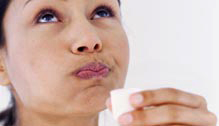 It is a little-known fact that one can treat respiratory infections quite effectively without drugs, primarily with the use of physical therapies and correctly applied remedies. Here are three methods:
It is a little-known fact that one can treat respiratory infections quite effectively without drugs, primarily with the use of physical therapies and correctly applied remedies. Here are three methods:
1. Therapeutic Gargling (TG). Many respiratory viral and bacterial infections commence with a sore throat or a small infection in the inside lining of the mouth–for instance, inside the cheek. In these cases, the invading microbe appears to establish a beachhead in the throat or mouth lining where it can safely multiply before the immune system can develop a response sufficient to wipe it out. Once the numbers of microbes reach a high enough level, they can break out and spread the infection throughout the respiratory tract or even system-wide.
Often a respiratory infection first announces its presence with a sore throat. At the moment when an individual first becomes aware of having a sore throat or infection in the lining of the mouth, the invading microbes are most vulnerable because they tend to be concentrated in one place–a small tract in the throat or mouth. So it is possible to use Therapeutic Gargling to destroy them.
After becoming aware of a soreness in the throat or mouth that is reminiscent of the soreness that heralded past infections, one should first make sure that one actually has a sore throat and is not just imagining it. Then, using a mouthwash such as salt water, green tea, or Listerine or a generic equivalent, one should gargle for 20 seconds. Repeat in 15 minutes, then every half hour for several hours, then at greater intervals. Gargling at least 10 times the first 24 hours and at least 5 times the second 24 hours gives the best assurance of full destruction of the microbes, though if one starts at the very early stage less gargling suffices.
TG is only fully effective if used within the first hour after a sore throat is noticed. However, even if this intensive kind of gargling is initiated only after the virus has started to spread from the throat, it may be able to reduce the severity and length of the respiratory disorder. In effect, untreated virus in the throat otherwise serves as reservoir fueling the spread of the disorder throughout the entire respiratory tract.
Therapeutic Gargling has only been tested informally in a few cases, so it clearly needs plenty of well designed clinical trials to validate and to work out an optimal protocol. But the results in individual cases are dramatic and easily explained: salt, green tea catechins, and ethanol are powerful microbicides that overwhelm the infecting microorganisms’ defenses.
TG is most useful for those with weakened immunity who are subject to frequent respiratory infections. It may not be necessary for people whose immunity is robust enough to fend off infections on its own. A critical question deserving of careful investigation: what percentage and kinds of respiratory infections start in the throat? Another: in which categories of individuals?
If TG were faithfully practiced by all vulnerable people worldwide, it could significantly or perhaps even dramatically reduce the incidence of respiratory infections and the resulting morbidity and mortality. It could also save many billions of dollars in medical costs.
It is also possible to use Prophylactic Gargling (PG), i.e., to gargle once or twice a day to prevent respiratory infections. The best results are obtained by using both PG and TG, as appropriate. However, an ethanol-based gargle should not be used for PG because of the danger of oral cancer with long-term use. In general, gargling with salt water has the fewest side effects.
2. Halotherapy, the use of aerosol dry microparticles of salt to treat respiratory disorders such as asthma, has been shown to be effective in acute respiratory infections as well. In a randomized, single-blinded trial with placebo controls, a treatment group of 80 and a control group of 80 were treated for 12 weeks with two weekly 10-minute sessions of inhaling from a halotherapy device and an empty device, respectively. After 3 months there were only 14 cases of acute respiratory viral infections and 104 days of symptoms in the treatment group whereas the control group had 55 infections and 585 days of symptoms (Chervinskaya, Alina V. Dry sodium chloride aerosol against acute respiratory infections. Eur Respir J 2009; 34: Suppl. 53, 401s).
3. Biophotonic Therapy (BT) is the leading phototherapeutic treatment of infectious diseases. BT has a sterling track record of effectiveness in the treatment of respiratory infections, including pneumonia. It has also been shown to be effective when used as an adjuvant therapy of tuberculosis. BT reduced the length of standard drug therapy, cut down on side effects, and led to better outcomes in a Russian study of the treatment of teenagers with TB (E.S. Ovsyankina, V.A. Firsova, V.G. Dobkin, and L.I. Rusakova, “Treatment of Acute and Progressive Forms of Tuberculosis in Teenagers with the Use of Intravenous Laser Irradiation,” Problemy tuberkuleza 2000, 14-17 [Russian]).
For further information, see Healing Photons and Intriguing Anomalies (especially the chapter on the use of Biophotonic Therapy and Electroaerosol Therapy in respiratory diseases).
It is likely that certain other physical therapies are also effective in treating respiratory infections; and it is possible that other kinds of non-drug therapy are likewise effective. Many physicians assume that only antibiotic and antiviral drugs can treat respiratory infections, but they are unaware of these treatments.
It is the duty of every medical practitioner who becomes aware of the antimicrobial properties of these therapies to learn to use them, to seek to test them as needed, to educate patients, and to use these excellent therapies to treat respiratory diseases.
*****
Kenneth J. Dillon is an historian who writes on science, medicine, and history. See the biosketch at About Us.
